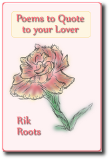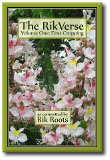Tuesday, July 12, 2005
Why is it important to conlang?
Today I shall evangelise about the Art of constructed languages - or for the anorak afficianados amongst us, conlanging.
Why? Because it's something we all do. Everybody conlangs. Every time a parent chatters away to their baby they're making up words, repeating nonsense sounds, singing to baby in a language peculiar to just themselves. Every time two people fall in love, they develop their own lexicon, their own shorthand ways of communicating between themselves - their very own private tongue. Groups of friends will play wordgames, coin neologisms, invent new rhymeslang. It's what helps bond people together, this ability to adapt the language to meet their particular needs. And it's what drives the language forward, evolving over time to renew itself afresh for each generation.
People need to communicate: it's genetic. If you don't believe me, then check out the development of the Nicaraguan sign language during the 1980s. There's also been hints of a phenomenon called "twin language", where twin siblings develop their very own language that they only use between themselves - and is soon lost when they enter the rough-and-tumble realities of school.
But what happens when a person takes this further? What happens when they devise a language so different from their own native tongue that nobody else in the world can understand it? Welcome to the wierd and terrible world of the conlanger.
The most famous conlanger at the moment must be J R R Tolkein, who developed a mythology (originally for England) that included gods and elves, dwarves, wizards and heroes. He also gave these people their own languages, influenced by living languages such as Welsh and Finnish, but not derived from them. These languages were his very own creation. But he's not the only one - there's lots of conlangers out there, drawn like flies to the stench of the internet - check out langmaker.com if you don't believe me.
Now, there's lots of reasons why people conlang. Some people are idealists who want to develop the perfect language that will solve the world's problems by getting people to talk to each other - though the reality is very different, as a quick browse of the auxlang mailing list archives will demonstrate. Others are linguists and/or polyglots who are mad on linguistics to such an extent that they'll investigate everything to do about languages. Some are keen on science fiction, often writing it and using a conlang to add a little bit of colour to the story. And for others it's just something that has to be done.
I'm one of that last group of conlangers. For me, conlanging is an art: a way of expression; a means for investigating the world around me.
I started conlanging when I was around 11 or 12, making simple "relexes" (relexifications) of English, and by my mid-teens I was developing something new, something different from English both in the things it had words for and in the ways those words came together. It was (and to some extent remains) a very private passion, in that I don't expect people to understand what I'm doing, or why, or even take much of an interest in my creation. This is my art, and I produce it to please me.
The internet changed a lot of things for me. It kickstarted my re-engagement with poetry for a start. But it also gave me a place to keep my conlang, and everything that arose from its development such as the maps, the stories, the society that speaks my language. Through the miracle of webpages, I found a way of displaying my passion, and for others to access it. Now this was a very scary thing for me to do! I never talked about my conlang to anyone - not friends, certainly not family. They didn't understand what I was doing, and I knew they didn't understand. We had an understanding, if you like. But the website meant that I now had an audience for my work - an audience that sometimes had the audacity to ask difficult questions like "what?", and "why?" So (defensively) I said: this is art.
And over the years that lie has morphed into a truth. My conlang is art. I make it art through the way I display it on the site. The words I choose to use is an act of art. The morphology and syntax I deploy in my conlang are artistic statements: this is the way I see the world through the prism of my conlang - is it not wonderful!?!. The stories are artistic compositions, the teach yourself section - even in its unfinished state - is an interactive artistic installation. Even the commentaries are part of the foundations of my art.
So there you have it. My name is Rik Roots and I am a conlanger! Haetu, ohsle ten! Geve telaa e.
Why? Because it's something we all do. Everybody conlangs. Every time a parent chatters away to their baby they're making up words, repeating nonsense sounds, singing to baby in a language peculiar to just themselves. Every time two people fall in love, they develop their own lexicon, their own shorthand ways of communicating between themselves - their very own private tongue. Groups of friends will play wordgames, coin neologisms, invent new rhymeslang. It's what helps bond people together, this ability to adapt the language to meet their particular needs. And it's what drives the language forward, evolving over time to renew itself afresh for each generation.
People need to communicate: it's genetic. If you don't believe me, then check out the development of the Nicaraguan sign language during the 1980s. There's also been hints of a phenomenon called "twin language", where twin siblings develop their very own language that they only use between themselves - and is soon lost when they enter the rough-and-tumble realities of school.
But what happens when a person takes this further? What happens when they devise a language so different from their own native tongue that nobody else in the world can understand it? Welcome to the wierd and terrible world of the conlanger.
The most famous conlanger at the moment must be J R R Tolkein, who developed a mythology (originally for England) that included gods and elves, dwarves, wizards and heroes. He also gave these people their own languages, influenced by living languages such as Welsh and Finnish, but not derived from them. These languages were his very own creation. But he's not the only one - there's lots of conlangers out there, drawn like flies to the stench of the internet - check out langmaker.com if you don't believe me.
Now, there's lots of reasons why people conlang. Some people are idealists who want to develop the perfect language that will solve the world's problems by getting people to talk to each other - though the reality is very different, as a quick browse of the auxlang mailing list archives will demonstrate. Others are linguists and/or polyglots who are mad on linguistics to such an extent that they'll investigate everything to do about languages. Some are keen on science fiction, often writing it and using a conlang to add a little bit of colour to the story. And for others it's just something that has to be done.
I'm one of that last group of conlangers. For me, conlanging is an art: a way of expression; a means for investigating the world around me.
I started conlanging when I was around 11 or 12, making simple "relexes" (relexifications) of English, and by my mid-teens I was developing something new, something different from English both in the things it had words for and in the ways those words came together. It was (and to some extent remains) a very private passion, in that I don't expect people to understand what I'm doing, or why, or even take much of an interest in my creation. This is my art, and I produce it to please me.
The internet changed a lot of things for me. It kickstarted my re-engagement with poetry for a start. But it also gave me a place to keep my conlang, and everything that arose from its development such as the maps, the stories, the society that speaks my language. Through the miracle of webpages, I found a way of displaying my passion, and for others to access it. Now this was a very scary thing for me to do! I never talked about my conlang to anyone - not friends, certainly not family. They didn't understand what I was doing, and I knew they didn't understand. We had an understanding, if you like. But the website meant that I now had an audience for my work - an audience that sometimes had the audacity to ask difficult questions like "what?", and "why?" So (defensively) I said: this is art.
And over the years that lie has morphed into a truth. My conlang is art. I make it art through the way I display it on the site. The words I choose to use is an act of art. The morphology and syntax I deploy in my conlang are artistic statements: this is the way I see the world through the prism of my conlang - is it not wonderful!?!. The stories are artistic compositions, the teach yourself section - even in its unfinished state - is an interactive artistic installation. Even the commentaries are part of the foundations of my art.
So there you have it. My name is Rik Roots and I am a conlanger! Haetu, ohsle ten! Geve telaa e.
Subscribe to:
Post Comments (Atom)










No comments:
Post a Comment